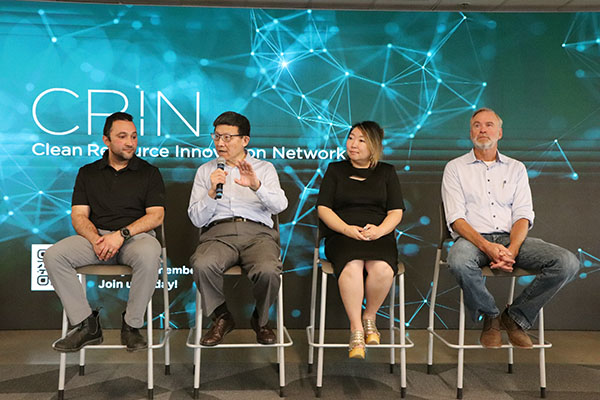Oct 17, 2024

Omar Moussa, Haibo Huang, Ling Bai, and Lowy Gunnewiek.
Event Recap: October 15 Project Café
CRIN hosted an exciting discussion on October 15 featuring progress updates from five innovators about their CRIN-supported projects.
Dr. Jerry Yao, Research Administrator at the Institute for Energy, Environment and Sustainable Communities at the University of Regina, shared details about the project Development of an Integrated Mobile System for Methane Utilization and Produced-Water Treatment – a collaboration between the University of Regina, The Petroleum Technology Research Centre (PTRC), and Ground Effects Environmental Services.
Yao said the project is currently at the halfway mark, with multiple successes marked so far.
The first milestone reached was the successful development of a methane gas collection and power generation module, which has been tested under various gas-emission conditions.
The second milestone was the development of the produced-water treatment module, using electrocoagulation and ceramic ultrafiltration technologies. The test runs have demonstrated an effective oil and contaminant removal rate, reducing the need for chemical additives and lowering energy consumption compared to conventional technologies. The module is designed to be mounted on a trailer, which can be deployed by a pickup truck to travel between multiple sites.
The next phase is the development of a smart operation and management system.
Lowy Gunnewiek, Chief Technical Officer and strategic advisor for New Wave Hydrogen, presented an update on the project A New Wave in Hydrogen Production.
“We’re using a really neat technology called a wave rotor,” he explained. “What that wave rotor is is a rotating bank of shock tubes, and what we’re doing is introducing a shock wave inside the wave rotor to convert pressure energy into thermal energy. And with that thermal energy, we’re driving the methane pyrolysis process.”
Gunnewiek noted the project is about applying proven technology to a new process.
Some of the accomplishments to date include the demonstration of methane pyrolysis in a shock tube in a laboratory setting, the development of complex kinetic models and sensors, the development of a field pilot and commercial designs, the expansion of industrial end-use applications for the produced hydrogen and carbon, and the production of six new patents.
Omar Moussa, Director, Carbon Strategy & Emissions at Breakwater Vantage, offered a summary of the company’s Methane Monitoring Technology project.
PoMELO, Portable Methane Leak Observatory, offers mobile-based methane emission detection and measurement.
The system went through five years of R&D before being deployed as part of a pilot project in 2021.
“Currently, PoMELO has five units in commercialization,” Moussa said. “These units are being used by producers and by our regulator in Alberta.”
Based on the pilot project, it takes up to four minutes for PoMELO to do a survey at a site, and it’s capable of doing a follow-up on the spot. Emissions are also verified with optical gas imaging.
In the future, the technology could potentially expand to other industries, and as it was developed in Alberta, it can operate year-round.
Ling Bai, the CEO of VL Energy, a seed-stage SaaS company, shared updates about the project Field Demonstration of Artificial Intelligence Powered Predictive Emissions Monitoring Systems.
VL Energy specializes in Real-Time Multi-Gas Emissions Monitoring through its Efficient and Secure Predictive Emissions Monitoring System (ES-PEMS).
The software-based solution uses artificial intelligence, machine learning, and cloud computing to continuously monitor and predict emissions in real-time, with data insights for optimization opportunities.
As part of its CRIN-sponsored pilot project with Suncor, VL Energy’s technology was successfully deployed in a large-scale setting, showing significant cost reduction, operational efficiency, and compliance reliability. A white paper was also published documenting the project details.
VL Energy is looking for new collaborations, pilot projects, and commercial contracts, Bai said.
Dr Haibo Huang, Director of the Energy Services Division at InnoTech Alberta and the manager of the AACI Research Program, shared details about the project Accelerated Advancement of a Dimethyl Ether (DME) Assisted In-Situ Bitumen Recovery Process.
The process replaces steam in the SAGD process through the injection of vaporized warm DME water at below 100 C in the same well configuration as the SAGD process.
The project objective was to advance the technology to TRL-7 by completing the experimental and engineering analysis to assess the viability of commercial application, and a preliminary field test design.
Project milestones included comparative semi-field scale experiments, process initialization method development, field scale simulation model development and DME injection process performance prediction, a simulation study of the DME injection process optimization, preliminary design and a cost estimate of surface facilities, and IP development.
An environmental impact assessment of the DME in-situ bitumen recovery process is in progress, two of the milestones are complete, and three are nearly complete.